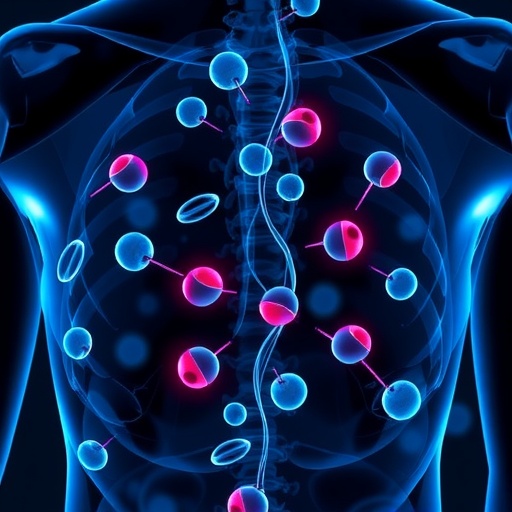
In a groundbreaking advance toward precision oncology, researchers have unveiled a novel antibody-drug conjugate (ADC) specifically engineered to target anaplastic lymphoma kinase (ALK)-expressing cancers. This innovative therapeutic agent combines a humanized antibody directed against ALK with a potent cytotoxic payload, pyrrolobenzodiazepine (PBD), demonstrating remarkable efficacy across multiple tumor models. The development marks a significant leap in the battle against malignancies driven by ALK alterations, which have long posed clinical challenges due to resistance to existing therapies and the heterogeneity of tumor behavior.
Anaplastic lymphoma kinase has emerged over the past decade as a critical oncogenic driver in a subset of cancers, most notably certain non-small cell lung cancers (NSCLC), anaplastic large cell lymphoma, and neuroblastomas. ALK rearrangements, mutations, or amplifications lead to aberrant signaling pathways that fuel unchecked proliferation and survival of cancer cells. Despite the availability of ALK inhibitors, resistance frequently develops, often through secondary mutations or bypass signaling mechanisms. Thus, there exists a pressing necessity to devise alternative therapeutic strategies that can overcome such challenges.
The newly developed antibody-drug conjugate leverages a humanized monoclonal antibody with high specificity toward the extracellular domain of ALK. By coupling this antibody to a PBD dimer—a class of DNA cross-linking agents characterized by exceptional cytotoxicity—the researchers have fashioned a targeted delivery system that internalizes into ALK-expressing cancer cells and unleashes the payload with lethal precision. PBDs are notable for their ability to form covalent bonds within the minor groove of DNA, inducing irreparable double-strand breaks that culminate in apoptotic cell death.
.adsslot_3KBluvGPFL{width:728px !important;height:90px !important;}
@media(max-width:1199px){ .adsslot_3KBluvGPFL{width:468px !important;height:60px !important;}
}
@media(max-width:767px){ .adsslot_3KBluvGPFL{width:320px !important;height:50px !important;}
}
ADVERTISEMENT
What sets this ADC apart from existing ALK-targeted agents is its dual mechanism of action. While traditional small-molecule inhibitors focus on kinase inhibition, this conjugate combines surface antigen recognition with direct DNA damage induction. This strategy addresses the limitations posed by kinase domain mutations that often render tumors refractory to enzymatic blockade. Furthermore, the humanized nature of the antibody component mitigates immunogenicity concerns, optimizing the therapeutic window for clinical translation.
In preclinical evaluations, the ADC demonstrated potent and selective cytotoxicity against a panel of ALK-positive cancer cell lines, while sparing ALK-negative counterparts. Functional assays confirmed efficient internalization and intracellular release of the PBD payload, with subsequent induction of DNA cross-linking and disruption of cell cycle progression. The compound’s specificity was further validated in three-dimensional tumor spheroid models and patient-derived xenografts, where robust tumor regression was observed without significant off-target toxicity.
Mechanistic studies elucidated a cascade of molecular events following ADC engagement with ALK-expressing cells. Upon binding, receptor-mediated endocytosis facilitates cellular uptake, after which lysosomal processing liberates the PBD warhead. The DNA lesions inflicted activate the DNA damage response pathways, including phosphorylation of histone H2AX and activation of p53-dependent apoptosis mechanisms. As a result, cancer cells fail to repair the damage and undergo programmed cell death, effectively reducing tumor burden.
Pharmacokinetic and biodistribution assessments revealed favorable properties for clinical application. The ADC exhibited a prolonged plasma half-life, allowing sustained exposure to tumor sites, and displayed limited accumulation in non-target tissues. These characteristics suggest a reduced risk of systemic toxicity, a notorious challenge in traditional chemotherapy. Importantly, dose-escalation studies in murine models established a maximum tolerated dose with a manageable safety profile, laying the groundwork for subsequent human trials.
Addressing tumor heterogeneity and acquired resistance remains a central hurdle in oncology. The ADC’s ability to target surface ALK offers an avenue to circumvent acquired resistance mutations within the kinase domain, as its lethality stems from DNA damage rather than mere enzymatic inhibition. Additionally, preliminary data hint at synergy when combining the ADC with existing ALK inhibitors or immunomodulatory agents, opening avenues for combination regimens that may enhance therapeutic outcomes and forestall resistance development.
The implications of this research extend beyond ALK-positive cancers. The modular architecture of the ADC platform allows potential adaptation to other oncogenic drivers by swapping the antibody component while retaining the highly potent PBD payload. This customizable approach aligns with the paradigm of precision medicine, wherein molecular profiling guides tailored therapies that maximize efficacy while minimizing toxicity.
However, certain challenges remain to be addressed before clinical adoption. The risk of bystander effects, where payload release affects neighboring healthy tissues, warrants rigorous evaluation. Furthermore, immune-related adverse events, though reduced by humanization of the antibody, cannot be fully ruled out. Future research will focus on optimizing linker chemistry to enhance payload release exclusively within tumor cells, refining dosing regimens, and exploring biomarkers predictive of response.
This pioneering antibody-drug conjugate heralds a new era in ALK-targeted therapy by marrying immunological specificity with chemotherapeutic lethality. Its promising preclinical profile fuels optimism for forthcoming clinical trials that could transform the management landscape of ALK-expressing malignancies. Given the frequency and lethality of such cancers, this ADC represents a beacon of hope for patients who have exhausted current treatment options.
In sum, the multidisciplinary effort spanning protein engineering, medicinal chemistry, and cancer biology underscores the power of integrative science in tackling formidable clinical challenges. The ADC’s sophisticated design elucidates how harnessing the vulnerabilities of cancer cells—target antigens and DNA repair mechanisms—can yield highly selective and potent therapeutics. As the oncology community eagerly awaits clinical data, this study substantially enriches the armamentarium against refractory ALK-driven tumors.
While significant progress has been made in dissecting ALK biology and its role in oncogenesis, this ADC confirms that targeting the cancer cell’s Achilles’ heel through innovative payloads remains a vital strategy. The versatile nature of PBD dimers, combined with antibody-mediated precision, may soon redefine standards of care not only in lymphoma and lung cancer but also in other malignancies marked by aberrant receptor tyrosine kinases.
Moreover, this work exemplifies the growing trend of conjugated therapies, which surpass the limitations of conventional chemotherapy and small-molecule inhibitors. By delivering “smart” drugs explicitly to pathological sites, patients benefit from increased efficacy and improved quality of life. As such, this research not only advances cancer therapeutics but also exemplifies the broader scientific pursuit of targeted, less toxic interventions.
Ultimately, the journey from molecular insight to therapeutic innovation encapsulated in this ADC project embodies the dynamic interplay between fundamental research and clinical ambition. The successful translation of this agent from bench to bedside could usher in remarkable improvements in survival and symptom management for patients afflicted by ALK-driven cancers, fulfilling the promise of precision oncology in practice.
Subject of Research:
Article Title:
Article References:
Guerra, A.D., Matkar, S., Acholla, C. et al. A humanized anaplastic lymphoma kinase (ALK)-directed antibody-drug conjugate with pyrrolobenzodiazepine payload demonstrates efficacy in ALK-expressing cancers. Nat Commun 16, 7578 (2025). https://doi.org/10.1038/s41467-025-62979-1
Image Credits: AI Generated
DOI: 10.1038/s41467-025-62979-1
Keywords: anaplastic lymphoma kinase, antibody-drug conjugate, pyrrolobenzodiazepine, targeted cancer therapy, ALK inhibitors, DNA cross-linking agents, precision oncology
Tags: ALK-targeted cancer therapyanaplastic lymphoma kinase researchantibody specificity in tumor targetingcancer treatment heterogeneity challengescytotoxic payloads in cancer treatmenthumanized antibody-drug conjugatenon-small cell lung cancer innovationsnovel cancer therapeutics developmentovercoming therapy resistance in cancerPBD dimer in oncologyprecision oncology advancementstherapeutic strategies for ALK alterations





